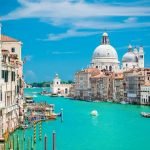March is a month of transition in Italy, offering a unique blend of winter charm and the first hints of spring. Traveling to Italy in March can be a rewarding experience for those looking to avoid the peak tourist season while still enjoying pleasant weather and cultural events. Whether you’re planning to explore historic sites, indulge in cuisine, or simply take in the scenic beauty, Italy has something special to offer during this time.
Italy in March typically experiences milder temperatures compared to the colder winter months, making it an ideal time for outdoor activities and sightseeing. However, it is important to be prepared for some variability in weather conditions, as occasional rain showers are not uncommon during this time. Packing layers and waterproof clothing is advisable to ensure comfort while exploring the diverse landscapes of Italy.
While March is considered shoulder season for tourism in Italy, popular destinations like Rome, Florence, and Venice may still experience moderate crowds. However, compared to the busy summer months, you can expect shorter lines at attractions and more availability at accommodations. Planning ahead and booking tickets in advance can help make your trip smoother and more enjoyable. Stay tuned to discover more about traveling through Italy in March.
Weather in Italy in March
March is a transitional month in Italy when it comes to weather. While it heralds the gradual arrival of spring, temperatures can still vary significantly across different regions of the country. Here is what you can expect in terms of weather in Italy in March:
- In northern Italy, cities like Milan and Venice may still experience cool temperatures ranging from 5°C to 15°C (41°F to 59°F). You might encounter some rain showers during your visit.
- Central Italy, including Florence and Rome, sees slightly milder temperatures with averages between 10°C to 18°C (50°F to 64°F). The chance of rain diminishes as you head south.
- Southern Italy, particularly in cities like Naples and Sicily, boasts the warmest temperatures in March, with averages ranging from 12°C to 20°C (54°F to 68°F). Expect sunny days and pleasant weather ideal for exploring.
If you are someone who enjoys mild weather without scorching heat or freezing cold, then March can be a good time to travel to Italy. The diverse climate throughout the country allows for a range of experiences depending on which region you choose to visit. It’s important to pack layers and suitable attire for changing weather conditions during your trip.
Crowds and Tourism in March
In March, Italy experiences a fluctuation in tourist crowds depending on the specific regions and attractions. While some popular destinations like Rome or Florence can still see a fair amount of visitors during this time, especially around spring break for many tourists, other areas may be less crowded. The good news is that compared to the peak summer months, March tends to offer a more relaxed and pleasant travel experience in terms of crowds.
Off-the-Beaten-Path Locations
If you prefer to avoid the hustle and bustle of tourist hotspots, March is an ideal time to explore off-the-beaten-path locations in Italy. Places like Sicily, Puglia, or Umbria may offer a more peaceful and authentic Italian experience without the overwhelming crowds seen in major cities. You can immerse yourself in local culture, indulge in traditional cuisine, and enjoy unique activities without feeling rushed or overcrowded.
Tourist Attractions and Popular Sites
While some attractions may still draw larger crowds in March, it is generally much quieter compared to the peak tourist seasons. Visiting iconic sites such as the Colosseum in Rome or the Leaning Tower of Pisa can be more enjoyable during this time as you can navigate through them with ease and appreciate their beauty without feeling overwhelmed by masses of tourists.
Plus, shorter queues at ticket counters make it easier to explore these must-see attractions at your own pace.
Whether you prefer serene countryside retreats or exploring famous landmarks at a leisurely pace, traveling to Italy in March offers a balanced mix of both worlds – a chance to enjoy popular spots with fewer crowds while discovering hidden gems off the beaten path. So, if you’re wondering “Is March a Good Time to Travel to Italy?” consider your preferences when it comes to tourism levels and choose accordingly based on what kind of experience you seek during your trip.
Festivals and Events in Italy in March
Italy in March is a vibrant time full of exciting festivals and events that showcase the rich culture and traditions of the country. One of the most famous events during this month is the Venice Carnival, where locals and tourists alike don intricate masks and costumes for a grand celebration. The festival features parades, masquerade balls, and live music, making it a truly magical experience for anyone visiting Italy in March.
Another popular event you can experience in Italy during March is the Feast of San Giuseppe, also known as St. Joseph’s Day. This holiday is celebrated all over Italy with elaborate altars dedicated to St. Joseph, traditional pastries like sfinge and zeppole are consumed, and communities come together for religious processions and feasts. It’s a great opportunity to immerse yourself in Italian cultural traditions and sample delicious local delicacies.
Furthermore, March in Italy marks the beginning of spring, which means cherry blossoms bloom across various regions of the country. One must-visit destination during this time is the Tuscan city of Florence, where you can witness the stunning display of cherry blossoms in full bloom at locations like Giardino Bardini or Parco delle Cascine. The picturesque scenery combined with pleasant weather makes it an ideal time to visit Italy and explore its beauty.
| Festivals & Events | Description |
|---|---|
| Venice Carnival | Grand celebration with parades, masks, and music |
| Feast of San Giuseppe | Celebration with altars dedicated to St. Joseph & traditional pastries |
| Cherry Blossom Blooms in Florence | Witness beautiful cherry blossoms blooming in iconic locations throughout Florence |
Best Places to Visit in Italy in March
March is a wonderful time to visit Italy as it marks the beginning of spring, with milder temperatures and fewer tourists compared to the peak summer season. If you are planning your trip to Italy in March, here are some of the best places to consider visiting:
- Rome: Explore the iconic landmarks such as the Colosseum, Vatican City, and Trevi Fountain without the overwhelming crowds. Enjoy a leisurely stroll through charming neighborhoods like Trastevere and indulge in delicious Roman cuisine.
- Florence: Admire famous art masterpieces at the Uffizi Gallery, climb up to Piazzale Michelangelo for panoramic views of the city, and visit the stunning Duomo. March also brings the blooming of cherry blossoms in Florence’s parks and gardens.
- Venice: Take a romantic gondola ride along the canals, visit St. Mark’s Square and Basilica, and get lost in the picturesque streets of Venice. March offers a magical atmosphere in Venice with fewer tourists meandering through its narrow alleys.
Whether you are interested in history, art, architecture, or simply soaking up the Italian culture, these cities offer a unique experience in March when the weather is pleasant for sightseeing and exploring.
In addition to these popular destinations, consider visiting smaller towns like Siena, Cinque Terre, or Lake Como to immerse yourself in local life and witness breathtaking scenery. These charming locations offer a more intimate experience away from the hustle and bustle of larger cities.
So if you are wondering if March is a good time to travel to Italy, rest assured that it is indeed an ideal month to visit this beautiful country. With fewer crowds, pleasant weather, and a variety of attractions waiting to be explored, Italy in March promises an unforgettable travel experience.
Budgeting for a Trip to Italy in March
When planning a trip to Italy in March, one of the key considerations for travelers is budgeting. March is considered shoulder season in Italy, which means that prices for accommodations and attractions are generally lower compared to the peak season. This can be advantageous for travelers looking to explore Italy on a more modest budget. Additionally, with fewer crowds during this time, travelers may find better deals on flights and accommodations due to decreased demand.
Accommodation Costs
In March, accommodation costs in Italy tend to be more affordable compared to the summer months. Travelers can take advantage of discounted rates at hotels and vacation rentals throughout the country. It’s also a good idea to consider staying in smaller towns or villages rather than major tourist hotspots like Rome or Florence, as prices are typically lower in these areas. Booking accommodations in advance can help secure the best deals and ensure a stress-free stay in Italy.
Dining and Food Expenses
When it comes to dining out in Italy, travelers can still enjoy delicious meals without breaking the bank in March. While some restaurants may have slightly higher prices than off-peak seasons, overall dining costs are manageable.
Visitors can also save money by opting for local trattorias and family-owned restaurants that offer authentic Italian cuisine at reasonable prices. Additionally, exploring local markets and grocery stores for fresh produce and ingredients is a great way to experience Italian culture while saving on food expenses during your travels.
Overall, budgeting for a trip to Italy in March is relatively straightforward with proper planning and research. By taking advantage of lower accommodation costs, dining strategically, and choosing alternative transportation options like trains or buses, travelers can enjoy an affordable yet unforgettable experience exploring all that Italy has to offer during this time of year.
Tips for Traveling to Italy in March
When it comes to traveling to Italy in March, there are a few tips that can help you make the most of your trip. One important tip is to pack layers, as the weather in Italy during this time of year can be quite unpredictable.
While some regions may have mild spring-like temperatures, others may still experience cooler weather and occasional rain showers. Having a mix of clothing options will ensure that you are prepared for any type of weather.
Another tip for traveling to Italy in March is to book accommodations and tours in advance. Although March is not as crowded as the peak tourist season during the summer months, popular attractions and hotels can still fill up quickly, especially during weekends and around major events. By booking ahead of time, you can secure your preferred activities and accommodations, avoiding any last-minute availability issues.
Lastly, when traveling to Italy in March, it’s important to check ahead for any local holidays or festivals that may impact your travel plans. Some cities or regions may have special events or closures during this time, so being aware of these dates can help you better plan your itinerary.
Additionally, considering a mix of indoor and outdoor activities can be beneficial in case of inclement weather. Ultimately, with proper preparation and flexibility, March can be a wonderful time to visit Italy for those looking to avoid the large crowds and high temperatures of peak tourist season.
Safety and Health Precautions for Traveling to Italy in March
When traveling to Italy in March, it is essential to take into consideration some safety and health precautions to ensure a smooth and enjoyable trip. One of the most important factors to keep in mind is the weather. While March marks the beginning of spring in Italy, temperatures can still vary significantly between regions. It is advisable to pack layers of clothing and comfortable walking shoes to be prepared for any weather conditions.
Another important aspect to consider when traveling to Italy in March is the possibility of rain. The month of March often brings rainfall, especially in certain areas such as Venice or Milan. Travelers should bring an umbrella or a waterproof jacket to stay dry while exploring the beautiful Italian cities and countryside.
In terms of health precautions, it is recommended to have travel insurance that covers medical expenses in case of emergencies. Additionally, it is a good idea to pack a basic first aid kit with essentials such as pain relievers, bandages, and any necessary medications. Travelers should also be aware of local healthcare facilities in case medical assistance is needed during their trip. By taking these safety and health precautions, travelers can enjoy a worry-free journey through Italy in March.
Conclusion
In conclusion, March can be a great time to visit Italy for those looking to avoid the peak tourist crowds and high summer temperatures. While the weather may still be unpredictable with some rain and cooler temperatures, it offers a unique experience to explore this beautiful country without the hustle and bustle of tourists. The gradual arrival of spring brings blooming flowers, lush landscapes, and a sense of renewal that adds to the charm of Italy in March.
Furthermore, the festivals and events happening throughout Italy during this month provide an opportunity to immerse yourself in the local culture and traditions. From celebrating Carnevale in Venice to attending religious processions during Easter week, March offers a variety of experiences that showcase the richness of Italian heritage. Whether you are interested in art, food, history, or simply enjoying the picturesque scenery, there is something for everyone to enjoy in Italy during this time of year.
Ultimately, whether March is a good time to travel to Italy depends on your preferences and priorities. If you are willing to trade off perfect weather for fewer crowds and unique cultural experiences, then March could be an ideal time for your trip. Just remember to pack layers for varying temperatures, check for any travel restrictions or health precautions due to current events, and plan ahead to make the most of your visit to this remarkable country.
Frequently Asked Questions
What Is the Weather Like in Italy in March?
In March, the weather in Italy can vary depending on the region you are in. Generally, it is still transitioning from winter to spring. Northern Italy may still experience cooler temperatures while southern regions like Sicily and Sardinia can be milder and more pleasant.
Is Italy Worth Going to in March?
Italy can definitely be worth visiting in March for many reasons. The weather is starting to improve, crowds are fewer compared to peak tourist seasons, and prices for accommodations and attractions are often lower. It’s a great time to explore cities without the scorching summer heat.
What Is the Cheapest Month to Go to Italy?
The cheapest month to go to Italy is typically during the winter months of January and February. This is considered the off-peak season where airfares and hotel rates tend to be more affordable. However, it’s important to note that some attractions or restaurants may have limited hours or closures during this time.

I’m a passionate traveler, writer, and Italophile. My fascination with Italy’s history, art, and culture has led me on countless adventures across the Italian landscape. Through “I Live Italy,” I share my love for this extraordinary country and aims to inspire others to explore its boundless beauty.





